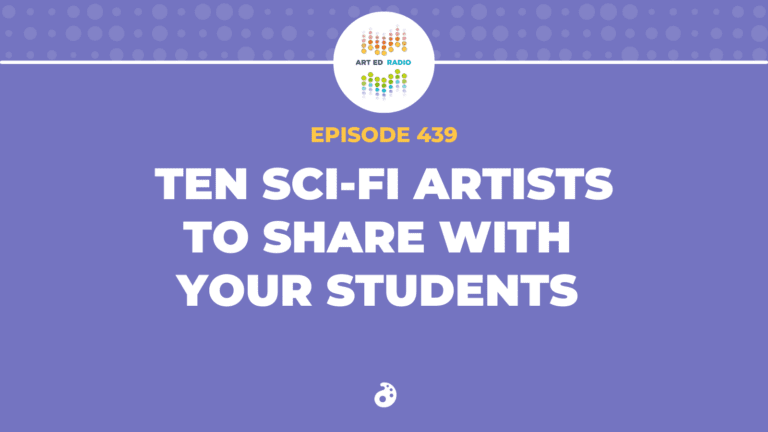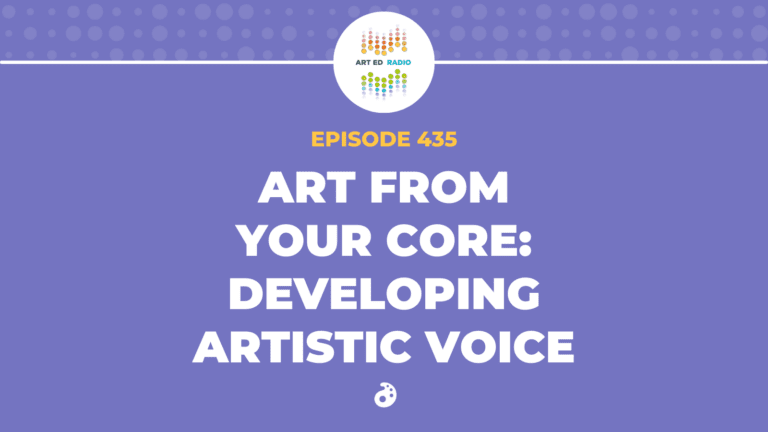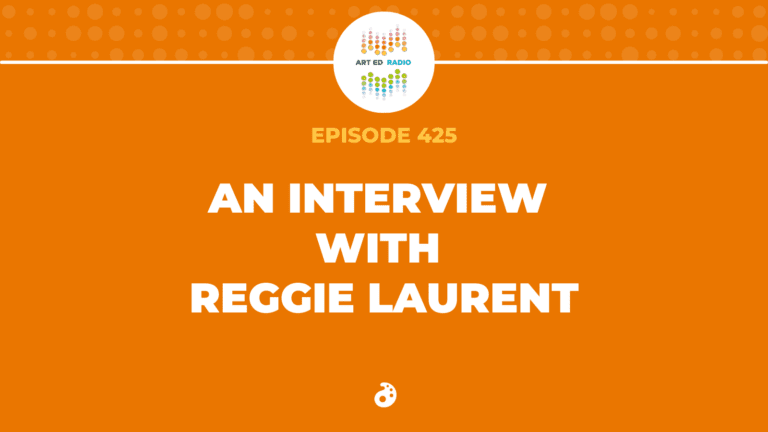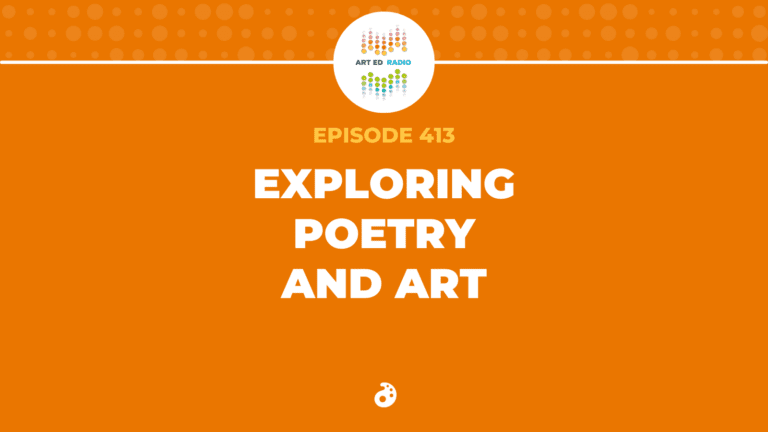Podcast conversations represent opinions of educational contributors from across the nation and do not necessarily represent the position of the Art of Education University or any of its academic offerings.
Today’s conversation comes to you from the recent NOW Conference. Sharonda Harris-Marshall, an art educator, artist, writer, and filmmaker, talked to Tim and Amanda about a variety of topics in this wide-ranging discussion. Listen as they cover how we deal with feelings of guilt and inadequacy, how we can help our students create meaningful work, and how we can help each student in our classroom find their own truth. Full Episode Transcript Below.
Resources and Links
- Listen to Sharonda’s last appearance on the podcast
- Articles to Support Art Educators and Teaching Social Issues
- See what the NOW Conference is all about
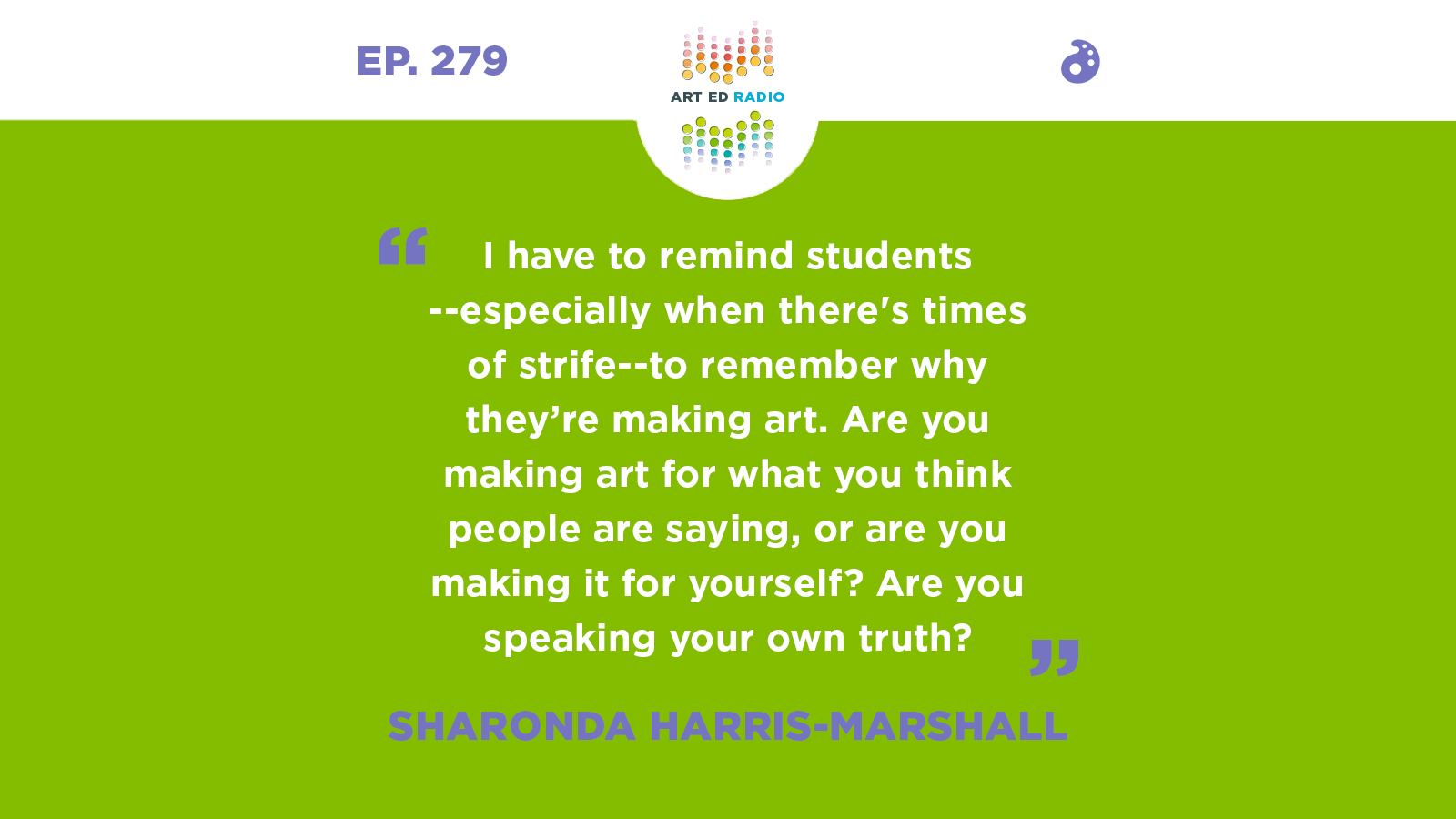
Transcript
Tim: Welcome to Art Ed Radio, the podcast for art teachers. This show is produced by The Art of Education University. I’m your host, Tim Bogatz. As I’ve talked about ad nauseam, we had the NOW Conference a couple weeks ago, and it was a great day, a lot of great presentations, a lot of great sharing, a wonderful chance to connect with other art teachers, and I’m hoping that we’re able to send everyone who attended back to school with some motivation, some new ideas, and new things to try out in their classroom this year. And I know a lot of teachers started back last week. Some even had students start back last week. Best of luck to you all who are already teaching. I know a lot of people are starting here in the middle of August, so good luck to everybody, and for those of you that don’t start for another few weeks, please enjoy that little bit of time off that you have left.
But anyway, the reason I started talking about the NOW Conference is that today’s episode will feature an interview from that conference. You will hear Amanda and me interviewing Sharonda Harris-Marshall. Sharonda is an art educator, and a filmmaker, and an artist, and a writer. The conversation that we had was really wide-ranging from talking about the guilt that we have when we’re not creating or not making art to the idea that making art that deals with current events and what we’re living through right now, to the idea of how we approach difficult conversations in our classrooms. I think it’s all worth hearing. I’m really excited to share it with you today. So, from the NOW Conference here is Amanda and me with Sharonda Harris-Marshall.
And we are going to begin hour three as promised with Sharonda Harris-Marshall. Sharonda is an artist, and a filmmaker, and a writer, and an art educator, and I don’t know, about a million other things. She’s very impressive. She joined us in February to talk about how we make art when times are difficult and how you can continue to stay creative. And then today we’re going to talk about how we can sort of help our students and ourselves create work that responds to everything that’s happening in the world around us. So, joining us now is Sharonda Harris-Marshall. Sharonda, how are you?
Sharonda: I’m well. How are you doing today, Tim?
Tim: It’s a great day. I love the conference, I got to say so we’re doing well. So, I guess I want to begin with a situation, ask you about a situation I think we kind of always face as creatives. It seems like when we’re not creating, which happens a lot with our teachers, we get busy, when we’re not always on, we kind of feel guilty about not creating, about not making work, and I’m sure that’s happened to you. What advice do you have or how do you deal with those feelings of guilt when we’re not actually making work?
Sharonda: Well, I know a lot of people, especially during the pandemic, were probably feeling a little bit of that. We’ve made all these lofty goals about what we’re going to do, what projects we were going to start, just like, “Oh, I’m going to work out all this time.” And then for whatever reason, whether it was because of supply chain issues with getting your weights or just the stress of the pandemic, they just didn’t happen, or they happen maybe at a slower pace than you wanted or you anticipated.
So, the first thing I do want to tell people, anybody who’s feeling guilty that they’re not writing their King Lear during the pandemic is, first of all, you’re probably too hard on yourself. I think a lot of us are feeling the same way. And one thing that the pandemic and a lot of the civil unrest that has happened has taught us is that we’re all not as… We’re not as lazy as we think we are. We need mental health days. We need time to take off and we’re seeing it now in real-time, even in the Olympics. Simone Biles performs at the highest level and yet she’s like, “I need to step back and take a break.” You can do the same thing. Sometimes it takes… You can just step back and do nothing. If watching Netflix and eating ice cream is the only thing you can manage right now, do that and clear your mind. You have to have that mental reset.
Tim: Yeah.
Amanda: That is excellent advice. So, that kind of leads into our next question. So, over the past couple of years, it has been really difficult to navigate our world for a whole variety of reasons. There’s a lot of things coming at us. There’s a lot of things coming at our students. So, what advice do you have for creating art during those times of conflict, or times of unrest, or times of strife? I guess, how can you get into it and what might it be able to do for you?
Sharonda: Well, let me say first that I teach college level. So, I teach mostly 18 to 24 with some adults. And the reason why I’m saying that is because the students that I teach, they don’t necessarily come from arts programs that they’ve had K through 12, or they might be deciding kind of now that they want to get into a creative field. And so, I’m trying to prepare them to be career-ready, which means they need to meet their goals, but also if they haven’t had that art background that has been established in so many other programs due to whatever reason, they’re going to have to be caught up to speed and then make goals. So, they’re going to have to perform and have to create. And as your challenge as an art instructor, or as a creative professional who is teaching other creative professionals is not only how do you motivate them to continue to make art or make or create for money because bills never will give you any grace, how you can create for money, but then also making sure that you’re creating the best that you can under stress and under conflict.
So, one of the things that I started to do with my students is I started to give them more open prompts. So, yes, they’re going to have to follow certain things, but I’ll say something like, “Hey, I’m just looking for…” One of the things that I teach in particular is photography. So, I’ll say, “Hi, this is a documentary photography project. Your prompt is to come up with a subject and cover that subject.”
Amanda: I love that so much.
Sharonda: That terrifies a lot of students, especially if they haven’t had that art background to just go in and have ideas. So, what I do to help them generate and create those ideas is I will ask pointed questions and help them break down their goals as much as possible in order to actually create. So, I’ll say to them, “Okay,” because they’ll ask me, “Well, I don’t know where to start.” “Okay. Well, what interests you in documentary photography? What type of subjects will interest you? Is the pandemic or anything that’s happening, is that motivating you? How are you feeling about this particular subject? Maybe have that as your starting point or your launching pad, and then see if you can narrow down what you need to do from there.”
So, for instance, this year I had a lot of students cover the pandemic in their own way, and that was kind of… It helped them cope with what was going on to tell their story from their perspective about the pandemic using art and using a creative medium. There’s so many ways to do it, I can talk about it forever, but I’m assuming we got to keep going.
Amanda: I think it’s interesting. I think there’s sort of, I mean, there’s, like you just said, a hundred tracks, but I think a lot of people either use it to process or to escape, and depending on what you need, you could use art for either one of those things right now.
Tim: Yeah, that’s actually what I wanted to ask about next was the process part of things because I think so many artists want to figure out how they can process what’s happening in the world, whether that be these huge events with pandemics or protests or climate change, or whatever is causing anxiety, whatever is causing stress. Making art is part of the way they process what’s happening. And so, Sharonda, I guess I want to ask you, have you noticed either your students or yourself or other artists, do you feel like there’s more pressure to create work when times are difficult? Is it more difficult for people to process their thinking and turn that into art when there’s so much happening?
Sharonda: Well, for me personally, it’s not because I’ve been creative all my life, but for some of my students who have not had that structure or that background before, this might be the first class that they’re taking that’s remotely creative, they do have issues because they will say something like, “This prompt is too open. You have to give me more instruction.” That’s usually the critique that I get back is that I’m giving them too much freedom. Some students feel very free to express themselves. They love it. They thrive in it, but others, the anxiety takes over, and then they shut down, and they don’t know how to cope with the freedom because they’re so used to saying, “Okay, you do A, you do B, you do C, you do D.” In a way, the pandemic was kind of like that too. It’s like, “Okay, you wear your mask. You social distance.” It’s a set of instructions. Some people were able to follow it and others just kind of broke down about it.
So, one of the things that I’ve been noticing about those students that are more anxious about being able to create and whether or not they have to overcome this fear of failure that is ultimately the bottom of how they’re feeling, you have to take a one-on-one approach with them. And of course, because me, I’m on the college level, I can do that. Ideally, all arts programs should have that option. Some students do better in a group setting, but the ones that are very anxious, at least for me, they do better if you are talking to them outside of their class. You just focus on them and kind of getting to know them as a person to try to have them express theirselves in a medium that helps. And then when you’re giving them, you just feed it to them little by little. They don’t really need more instruction. They think they need more instruction. What they need-
Amanda: That’s such a good point.
Sharonda: Yeah. They need to have that box defined for them maybe before they can break out of that box and really express themselves. So, I will help them with that process, think out their things. Like I was saying before, what are subjects that are important to you? What is it about the pandemic, or what is it about what’s going on politically that is bothering you? What’s this personal thing? How is things in your life right now? How are things in your life right now? What calms you down? What makes you happy? Do you like dogs? Okay, tell me about your dog. And then they’re able to craft a story about their dog or something, and then it’s like, “Okay. So, now thinking about your dog, how can you translate this into your assignment that is due on Friday at two o’clock?” And-
Amanda: Yeah, well that kind of… Oh, go ahead. I’m sorry. Go ahead.
Sharonda: Oh, no, no, go ahead. From there, they’re usually able to start at least outlining because I’m like, “Okay, first you need to outline what your goals are. What do you want to tell us? What are you trying to tell us in your art?” And then, yeah, that helps clarify things so they can meet their goals.
Amanda: Yeah. We wanted to dive a little bit deeper into that, too, it was a good segue, especially with current events because there are so many different ideas about current events, and people’s family members have different ideas about current events, and current events can bring up a lot of past traumas for students and things like that. So, how do you help students reflect and create work about what’s going on right now, just not maybe their likes or dislikes, but things that are happening in the world? Do you have any tips about helping them sort of reflect or anything else that you wanted to add to the discussion we were just having about that?
Sharonda: Well, we’re here to help their critical skills, I guess that’s the way to say it, and especially on the college level where that makes or breaks you because we are trying to get them career-ready. So, a lot of the times, it is just trying to take whatever feels more abstract to them and making it more personal to them. So, for instance, let’s just say some of the civic unrest happened and it’s funny because I am a Black instructor, but most of my students are White. I’m a Black instructor in Nebraska, and most of my students are White, and what happened last year with George Floyd was an eye-opener for a lot of my students. And so, first of all, I had to give them that space to ask me any questions because this might be the first time that they have encountered something where they are like, “Okay.” They feel that this is wrong, and they feel like they need to say something or speak out, and they’re just a 19-year-old kid from Nebraska. They don’t know what to do and how to feel.
And so, as the instructor, even though I’m the marginalized person, as the instructor, I had to take it among myself to sit there and say, “Okay. Well, I’m glad you’re feeling this way. What other ways that we can help you assess what happened? Can you exactly tell me how you’re feeling and what do you think a solution is? Is there a solution and what would that solution look like to you?”
Amanda: I think that’s so powerful, turning it back to them.
Sharonda: Yes.
Amanda: Yeah.
Sharonda: We’re all internalizing all sorts of things, and then some of us also internalize things by just blocking it out of our head. There were some students that does… They don’t want to go that route, and then they’re going to be a lot here, especially with me, I am of the position that all art is political or all art is saying something, but some people are like, “I don’t need my art to say anything.” I would argue that’s a political stance, but at the same time, that is their choice to say, “I don’t want that to affect my life right now. I’m making art for me, and I’m making art for myself.” And I have to remind students that, especially when there’s times of strife, who are you making art for. Are you making art for what you think people are saying, or are you making it for yourself? Are you speaking your own truth? And of course, as an instructor, you have the responsibility not to censor that truth.
Tim: Yeah. Okay, so I want to ask about one thing, just your comment about having those open conversations about talking with your students got me thinking. What advice would you have for teachers who want to open up conversations in their classroom? Or I guess we can also look at it this way, for kids who aren’t used to those conversations, who don’t have those experiences, how do we amplify different perspectives? How do we amplify the voices that need to be heard as part of that discussion?
Sharonda: Well, I have a lot of experience in this area. I did not grow up in… For instance, I’m just using Nebraska as… I hope anyone who’s from Nebraska is not taking any of this-
Amanda: Tim is from Nebraska so you’re good.
Tim: I know what she’s saying about this. I’m from Omaha. Yeah, you’re not wrong.
Sharonda: I’m just saying this because the experience that I would have, I would talk more candidly about race, and being from the South, I am more open about certain subjects, and I sometimes might say something like that in my classroom. And yeah, some students, this is the first time they’re hearing about this, or they don’t know how to process it, or they’re feeling, I’m just going to use the term, they’re feeling some White guilt maybe, or they’re feeling some male guilt or anything. They’re feeling in a way that shuts them down, and then they may not be able to function to do their own goals in the class.
Those students, I might have to help on a certain level, but for the others that feel marginalized or the others that need their voices amplified, it’s important to me again, like I was saying, to make sure that you are encouraging those voices, but do not censor those voices. Even the other students that are feeling the way that they’re feeling if it’s the first time they’re hearing about it and they don’t know how to process, that student’s truth is that student’s truth. So, you might have to have a conversation, and then there’s going to be some students that will argue with the other students in your class. I’ve had that happen before about a subject, and then this other student disagreed, and then this other student disagreed, and they feel shut out, and then they feel marginalized in there. As an instructor, it’s kind of this balance of making sure that your class stays civil, but also to make sure that every student feels heard. It’s all of that.
And then students are real good, at least on my level because they’re 18 to 24, they’re really good at saying, “Everybody agrees on this side. That one person over there doesn’t agree.” As an instructor, you are responsible to make sure everybody is in the same space to create, to learn, and to do critiques effectively because again, that’s another thing that we have to do on the college level. They’re going to have to learn how to critique. And so, if you’re looking at something and another student isn’t agreeing with whatever that student has portrayed, you have to learn as an instructor to steer that conversation away to just what is being depicted or introduce the fact that you can look at something one way, another person who’s viewing it can look at it another way, and that both of those assessments are correct.
Tim: Yes, yes.
Amanda: Yeah, I literally got chills when you said every student knows their own truth. That’s so important to remember because everybody does have a different lived experience and they’re bringing so much beyond their one painting that you’re critiquing or whatever. There’s a whole lifetime of experience that comes before that discussion. So, it’s a really good reminder.
Tim: Absolutely, and I would just say it’s a very tough balancing act, as you said, especially when you’re doing this in high school or even middle school, that can be very difficult, but I think it is worthwhile to allow those voices to be heard. Sharonda, thank you so much for joining us. It was awesome to talk to you. We appreciate your perspective. Thank you so much, and hopefully, we can talk to you again soon.
Sharonda: All right.
Amanda: Thank you so much.
Sharonda: Thank you. Thank you. Thank you, Tim.
Tim: Thank you so much to Sharonda for talking to us at the conference. She offered a lot of great insight, a lot of things to think about, and hopefully, some takeaways that can come into your classroom this year. So, I appreciate her giving us her time and I really appreciate that conversation. I’m really happy that we’re able to share it with you. So, thank you all for listening.
Art Ed Radio is produced by The Art of Education University with audio engineering from Michael Crocker. Thank you as always for tuning in, and we will talk to you again next week.
Magazine articles and podcasts are opinions of professional education contributors and do not necessarily represent the position of the Art of Education University (AOEU) or its academic offerings. Contributors use terms in the way they are most often talked about in the scope of their educational experiences.
